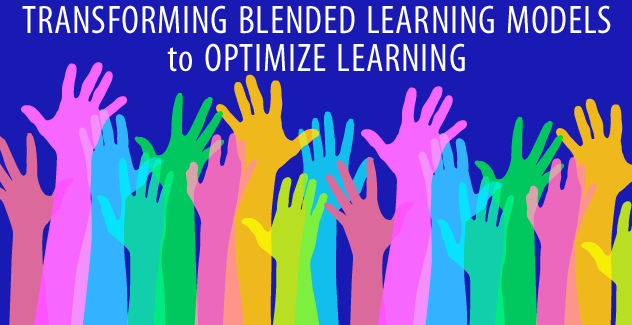
There are many Blended Learning models but which one works best for you and your subject? In this blog post, Robert Godwin-Jones will share the model that works best for his classroom and provide guidance on how to choose the model that would work best for you.
Transforming to Blended Learning Models Format to Optimize Learning
I teach all my courses now, if possible, in a hybrid or blended learning format. In this post, I will discuss why and how I’ve traversed the path from face-to-face to totally online to my present preference. The format I use is the so-called flipped classroom model, with the content delivery taking place outside of in-person meetings. The format which works best for course delivery will depend on the instructional context and discipline. I do believe that the blended learning format works best in most instances, but the model that fits best may not be the flipped classroom, but rather could be station rotation or another model. In my case, I teach mostly two kinds of courses, skills courses in foreign languages and international studies courses, taught in English. The international studies courses mostly have a mix of content (learning about other cultures, studying paradigms for comparing cultures) and skills (using appropriate communication styles, recognizing the need to adjust verbal or nonverbal communication). I’ll address here this latter kind of course, as it is more applicable to the largest number of disciplines, in that traditionally lectures tend to be one of the main devices for content delivery.
The original face-to-face version classroom model
The course I am using as the example is “Communicating across cultures”. For the in-class lectures, I created PowerPoint slides, which incorporated both graphics and short video clips in order to make them as lively and memorable as possible. I always invited students to interrupt if they had questions or if they wanted to add comments, objectives, or pertinent personal experiences. That rarely happened. There were class discussions after the lecture, but time was typically short, so opportunities for students to contribute were limited. In class discussions, the same students tended be the ones to speak. I would also ask several students who didn’t volunteer to voice their views, but many were reluctant. I did use small group discussions, which provides better opportunities for more students to contribute. Monitoring the groups, however, showed me that the dynamics of the conversations varied considerably from group to group. Often one student would dominate the group discussion.
Moving the course online
Moving the course totally online improved both the content delivery and the student participation in class discussions, and as a consequence the potential for improved student learning outcomes.
Content was enhanced not only through digitization of lectures, but also by incorporating the narrated presentations into web-based tutorials, created with SoftChalk, which included materials which illuminated the content in a variety of ways. That included inserting a set of key terms, a list of unit learning objectives, a short video used as an advanced organizer, links to additional online resources, and, most importantly, a set of formative assessments to check student uptake of the content. Just having the lectures as digital video was beneficial in itself, as students could pause or replay segments. An optional presentation outline assisted comprehension and notetaking.
Student interactions with the content were improved considerably through having students use both online discussion forums and reflective journals. These provided a public space (discussion forums) to engage with other students as well as a private channel (reflective journals) to offer personal insights. This enabled all students to participate fully in the discussion, not just those who were most vocal or outgoing. The online venues for discussion provided a safe environment which allowed for class participation by all students. The written work also provided a means for students to demonstrate and apply what they had learned, which has proved to be a more effective vehicle for assessment than multiple choice or other kinds of in-class quizzes.
The blended learning mode: Optimizing learning and interactions
While the online version of the class was in many ways an improvement over the face-to-face format, there was a significant loss, namely the opportunity to connect in person. That includes peer interactions as well as teacher-student connections. Although it is possible to connect through video teleconferencing with Skype or other services, it’s not the same as encountering one another face-to-face. Studies have shown that although video conferencing appears to mimic closely in-person conversations, the medium does not deliver the equivalent experience. Partners are not making direct eye contact, but looking at the camera. The camera focuses on head and shoulders, so that gestures and body language are not included. Additionally, the online conversations do not easily lend themselves to the kind of serendipitous interactions available when people come together in person. Those may lead to deeper connections and relationships.
In a blended learning model, face-to-face meetings (in my case once a week) tend to become more dynamic and productive, in that students come to class having worked through the content at home and ready to engage with other students in the class. This social learning component can add to deeper learning. Students are able in class to clarify anything unclear from the online content or to pursue more detailed or related knowledge. Another advantage of the hybrid format is the opportunity to use in-person meetings for activities such as skits, student reports, or collaborative activities. While some of these can be replicated online, others will be more difficult to implement.
That is how a hybrid format enables the best of both worlds—the personal connection of in-person meetings and the efficiency and egalitarianism of online delivery.
About 12: 12, is a founding partner and responsible for product research and design. Prior to SoftChalk, Robert was a founding partner of madDuck Technologies where he was a co-developer of the Web Course in a Box Learning
Management System. He is the former Director of the Instructional Development Center at Virginia Commonwealth University and is currently a faculty member in their School of World Studies. His principal areas of research are in applied linguistics and international studies. He writes a regular column on emerging technologies for the peer-reviewed journal Language Learning & Technology (llt.msu.edu) and blogs on intercultural communication at http://acrossculturesweb.com/wp/.

Leave a Reply